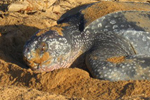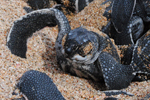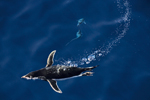Even as concentrations of carbon dioxide in the atmosphere hit 400 parts per million (ppm) for the first time in human history last week, a new study in Nature Climate Change warns that thousands of the world’s common species will suffer grave habitat loss under climate change.
“While there has been much research on the effect of climate change on rare and endangered species, little has been known about how an increase in global temperature will affect more common species,” says lead author Rachel Warren from UEA’s school of Environmental Sciences and the Tyndall Centre for Climate Change Research.
Looking at the habitat requirement so of 48,786 common land plant and animal species, scientists found that 34% of animals and 57% of plants will see over half of their habitat lost by 2080 if temperatures rise 4 degrees Celsius above the pre-industrial average. According to the study, plants, reptiles, and amphibians are the most vulnerable, while the Amazon, Central America, Sub-Saharan Africa, and Australia are expected to be the hardest hit.
Even worse, Warren says the estimates are “probably conservative” since they didn’t take into account rising extreme weather, disease, and pests, adding that “animals in particular may decline more as our predictions will be compounded by a loss of food from plants.”
Such catastrophic losses would have a major impact on humans as “these species are important for things like water and air purification, flood control, nutrient cycling, and eco-tourism,” according to Warren.
While nations have pledged to keep global temperatures from rising above 2 degrees Celsius, that goal appears increasingly elusive as global greenhouse gas emissions continue to rise year-after-year. If business as usual continues, temperatures could rise well above 4 degrees Celsius by the end of the century.
However, the study also finds that if nations keep their current goals on climate change (i.e. temperatures don’t rise above 2 degrees Celsius) than the loss to common species would be mitigated significantly. But time is not on our side: if emissions peak in 2016, losses to species would be reduced by 60 percent, while waiting until 2030 would mean losses reduced by only 40 percent.

Unidentified red caterpillar in the Amazon. The new study finds that Amazonian wildlife will be hit especially hard by climate change. Photo by: Rhett A. Butler.
CITATIONS: Warren R, van der Wal J, Price J, Welbergen JA, Atkinson I, Ramirez-Villegas J, Osborn TJ, Jarvis A, Shoo L, Williams S and Lowe J. Quantifying the benefit of early climate change mitigation in avoiding biodiversity loss. Nature Climate Change
Related articles
The Hawaiian silversword: another warning on climate change

(05/06/2013) The Hawaiian silversword (Argyroxyphium sandwicense), a beautiful, spiny plant from the volcanic Hawaiian highlands may not survive the ravages of climate change, according to a new study in Global Change Biology. An unmistakable plant, the silversword has long, sword-shaped leaves covered in silver hair and beautiful flowering stalks that may tower to a height of three meters.
Leatherback sea turtles suffer 78 percent decline at critical nesting sites in Pacific

(02/27/2013) The world’s largest sea turtle, the leatherback (Dermochelys coriacea), is vanishing from its most important nesting sites in the western Pacific, according to a new study in Ecosphere. Scientists found that leatherback turtle nests have dropped by 78 percent in less than 30 years in the Bird’s Head Peninsula on the island of New Guinea. Worryingly, these beaches account for three-fourths of the western Pacific’s distinct leatherback population; globally the leatherback is listed as Critically Endangered by the IUCN Red List, the highest rating before extinction.
Will Amazon species lose the climate change race?

(02/14/2013) Deforestation could increase the risk of biodiversity loss in the Amazon by forcing species to migrate further in order to remain at equilibrium with changing climates, says new research. “As migration models are made more realistic through the inclusion of multiple climatic, biotic, abiotic and human factors, the predicted distances between current and future climate analogues invariably increases,” Kenneth Feeley, lead author of the paper published in Global Change Biology, told mongabay.com.
U.S. proposes to list wolverine under Endangered Species Act
(02/05/2013) Arguably one of the toughest animals on Earth, the wolverine (Gulo gulo) may soon find itself protected under the U.S.’s Endangered Species Act (ESA) as climate change melts away its preferred habitat. Last week, the U.S. Fish and Wildlife Service (FWS) announced it was proposing to place the world’s largest terrestrial mustelid on the list. Only 250-300 wolverines are believed to survive in the contiguous U.S.
Cute koalas have become ‘urban refugees’

(01/28/2013) According to Susan Kelly, koalas have become “urban refugees,” under siege by expanding cities that bring with them deforestation, dogs, traffic, and other ills for native wildlife. Director of Global Witness, and writer, producer and director of the new documentary Koala Hospital, Kelly has spent 3 years working to understand the rising threats to one of the world’s most beloved marsupials. While Koala Hospital highlights the many perils facing koalas, including climate change due to record fires across Australia, it also looks at the efforts of individuals who work to save koalas one—by—one at Port Macquarie Koala Hospital, taking in patients who have been orphaned, hit by cars, scarred in fires, or attacked by dogs.
Global warming – 56 million years ago

(01/23/2013) Sandy, Irene, Katrina… Hurricanes are fast becoming household names and have many people worried over the connection between extreme weather and the amount of greenhouse gases people are pumping into the atmosphere. No one can predict for sure what will happen decades or centuries from now as such gas concentrations increase. But scientists have a pretty good picture of what did happen in the past; greenhouses gases were released into the atmosphere in massive amounts at least once before—around 56 million years ago.
Mountain pine beetle threatening high-altitude, endangered trees
(01/02/2013) In the western U.S., few trees generally grow in higher altitudes than the whitebark pine (Pinus albicaulis). Providing shelter and food for bears, squirrels and birds, the whitebark pine ecosystems also help regulate water flow from snowmelt. But, according to a new study in the Proceedings of the National Academy of Sciences (PNAS), climate change has produced a novel threat for these high-altitude forests : mountain pine beetles (Dendroctonus ponderosae).
Reduction in snow threatens Arctic seals

(11/28/2012) Arctic snowfall accumulation plays a critical role in ringed seal breeding, but may be at risk due to climate change, according to a new study in Geophysical Research Letters. Sea ice, which is disappearing at an alarming rate, provides a crucial platform for the deep snow seals need to reproduce. Ringed seals (Phoca hispida) require snow depths of at least 20 centimeters (8 inches): deep enough to form drifts that seals use as birth chambers.
Climate change threatens population of Earth’s largest sea turtle

(11/19/2012) A drier, hotter climate in Central America could wipe out the population of leatherback sea turtles from the eastern Pacific Ocean by the year 2100, according to a grim projection published on July 1 in Nature Climate Change. Already critically endangered from fisheries by-catch and historic egg poaching, leatherbacks can hardly accommodate another human-related threat. Yet scientists still hold out hope for interventions that could save the turtles.
Bats face new perils from climate change

(11/15/2012) Global climate change could devastate bat populations around the world, threatening to tear yet another thread from the tapestry of biodiversity should current temperature trends persist, according to a new study. “Bats were the focus for this study because they are relatively understudied but due to their sensitivity to environmental stress, they are excellent indicators of climate change,” Hayley Ann Sherwin, co-author of the paper published in Mammal Review, with the Queen University in Belfast, told mongabay.com.
Penguins face a slippery future

(09/26/2012) Penguins have spent years fooling us. With their image seemingly every where we turn—entertaining us in animated films, awing us in documentaries, and winking at us in commercials—they have made most of us believe they are doing just fine; the penguin’s charming demeanor has lulled us into complacency about their fate. But penguin populations are facing historic declines even as their popularity in human society rises. Overfishing is decimating some of their prey species, climate change is shifting their resources and imperiling their habitat, meanwhile pollution, such as oil spills, are putting even healthy colonies at risk. Now, a young organization, the Global Penguin Society (GPS), is working to save all of the world’s 18 penguin species by working with scientists, governments, and local communities.
Climate change may be worsening impacts of killer frog disease
(08/13/2012) Climate change, which is spawning more extreme temperatures variations worldwide, may be worsening the effects of a devastating fungal disease on the world’s amphibians, according to new research published in Nature Climate Change. Researchers found that frogs infected with the disease, known as chytridiomycosis, perished more rapidly when temperatures swung wildly. However scientists told the BBC that more research is needed before any definitive link between climate change and chytridiomycosis mortalities could be made.
Past climate change reduced lemur population in Madagascar
(07/24/2012) Climate change that took place 4,000-10,000 years ago may have contributed to the endangered status of one of Madagascar’s rarest lemurs by reducing the extent of its habitat, argues a new study published in the journal Proceedings of the Natural Academy of Sciences.